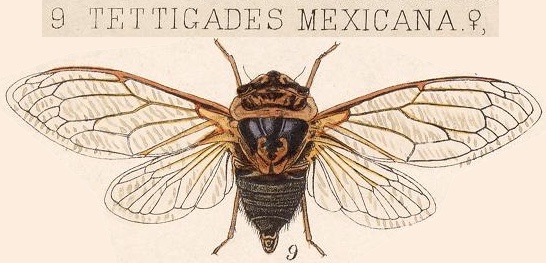Tettigades mexicana Distant, 1881, is a cicada found in Mexico.
Scientific classification:
Family: Cicadidae
Subfamily: Tibicininae
Tribe: Tettigadini
Genus: Tettigades
Species: Tettigades mexicana Distant, 1881

Species description by W. L. Distant:
Head above black, front with an arcuated fascia at each, side of base of face on anterior margin, an indistinct, narrow, broken, central longitudinal fascia on vertex, and a broad streak behind inner margin of eyes, luteous. Pronotum with the disk ochraceous, having a large reversed triangular spot on anterior margin, a large oblique patch on each side behind eyes, and a small central transverse line near posterior margin fuscous; anterior border narrowly, lateral and posterior borders broadly luteous. Mesonotum black, with two central pale lines commencing on anterior margin and terminating about one third the length of mesonotum; basal elevation with large horn-like and branching angles extending therefrom to about centre of disk, and frenum, luteous. Abdomen black, strongly pilose, with the posterior segmental borders narrowly ochraceous. Underside of body and legs luteous ; base and central fascia to face, inner margin of eyes, some irregular marks on sternum and near coxae, a linear streak on each side of femora, a spot on trochanters, a marginal segmental row of spots to abdomen, and a large quadrate spot on apical segment fuscous. Tegmina pale hyaline; radial and postcostal veins, and venation of apical third of tegmina fuscous; postcostal ulnar ramus and remaining venation luteous. “Wings pale hyaline; basal half of venation luteous, apical half fuscous.
The face is moderately convex and gibbous, distinctly transversely striated, with a broad central longitudinal sulcation, the edges of which are slightly raised. The rostrum in the typical specimen has the apical joint mutilated, but apparently about reaches the posterior coxa?. The anterior femora are armed with two strong spines. Body very strongly pilose.
Long. 22 millim., exp. tegm. 68 millim.
References:
- The illustration comes from Biologia Centrali-Americana. Insecta. Rhynchota. Hemiptera-Homoptera. Vol. 1. By W. L. Distant F.E.S. and The Rev. Canon W. W. Fowler, F.L.S. (1881-1905). Read it on the Biodiversity Heritage Library website.
- Species name information comes from Allen Sanborn’s Catalogue of the Cicadoidea (Hemiptera: Auchenorrhyncha).


 What’s interesting is the Hodgkinia bacteria became two distinct species for no particular discernible reason (nonadaptive evolution). Separate, either of the species would be useless to the cicada because they produce an incomplete set of nutrients, but together they produce the compete set of nutrients. Two function as one, that once was just one. Ed Yong does a thorough job of explaining this
What’s interesting is the Hodgkinia bacteria became two distinct species for no particular discernible reason (nonadaptive evolution). Separate, either of the species would be useless to the cicada because they produce an incomplete set of nutrients, but together they produce the compete set of nutrients. Two function as one, that once was just one. Ed Yong does a thorough job of explaining this 